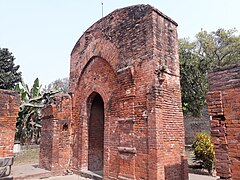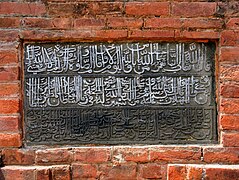Sayed Jamaluddin Mosque
| Sayed Jamaluddin Mosque | |
|---|---|
مسجد سيد جمال الدين | |
 | |
| Religion | |
| Affiliation | Islam |
| Location | |
| Location | Hooghly district, West Bengal, India |
| Architecture | |
| Style | Islamic architecture |
Sayed Jamaluddin Mosque (Bengali: সৈয়দ জামালুদ্দিনের মসজিদ, Arabic: مسجد سيد جمال الدين) is a former mosque and archaeological site located in the ancient city of Saptagram in Hooghly district, West Bengal. The mosque was built during the reign of the Bengali sultan Nasiruddin Nasrat Shah.[1]
History
[edit]A stone foundation plaque attached to the mosque states that it was constructed by Sayed Jamaluddin, son of Sayed Fakhruddin of Amol during the reign of Nasiruddin Nasrat Shah. The date mentioned in the inscription is Ramadan 936 AH which corresponds to May 1529. Within the mosque complex are three tombs, which belong to Sayed Fakhruddin, his wife and his eunuch.[2]
Architecture
[edit]It is a unique brick built mosque decorated with terracotta ornamentation. It represents the terracotta elements of the Islamic architecture of Bengal.[3] There are three tombs in the mosque complex. At present the ruined mosque is under the maintenance of Archaeological Survey of India (ASI).[1][4][5]
Gallery
[edit]-
Signboard
-
Entrance
-
Inscription
-
Pillars
-
Terracotta work
-
Terracotta work
References
[edit]- ^ a b "বাংলায় ভ্রমণ -দ্বিতীয় খণ্ড". bn.wikisource.org. Retrieved 30 November 2018.
- ^ Ahmad Hasan Dani (1957). "Analysis of the Inscriptions". Asiatic Society Of Pakistan Vol-ii. p. 71.
- ^ "Tracking the ancient terracotta mosques of Bengal". Retrieved 30 November 2018.
- ^ "Syed Jalamuddin Mosque, Adisaptagram". Wikimedia Commons, the free media repository. Retrieved 30 November 2018.
- ^ "Alphabetical List of Monuments – West Bengal". asi.nic.in. Retrieved 3 December 2018.






